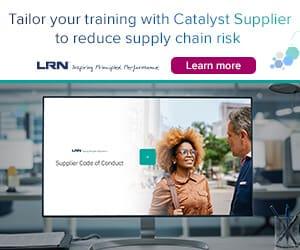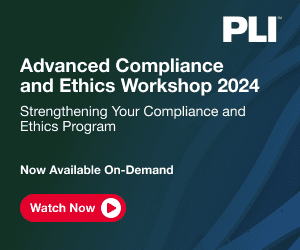This week was the 10th Anniversary of the UN Global Compact’s 10th Principle: “Businesses should work against corruption in all its forms, including extortion and bribery.” The celebration this past Wednesday is a testament to the inspirational leadership and unwavering commitment of Georg Kell, Executive Director of the UN Global Compact, and Olajobi Makinwa, Head of Transparency & Anti-Corruption Initiatives. The 10th anniversary is a sign of how far business has come and the progress it has made on its journey—and where it still needs to grow.
Looking Back: The Journey From Amoral to Moral Business
Ten years ago, before Enron and the Financial Crisis, talking about ethics in the context of business was a conversation stopper, much less a global campaign to combat corruption. We heard over and over again a version of that famous line from The Godfather, “it’s not personal, it’s just business.” We attended funerals where the deceased was remembered as simultaneously a “ruthless negotiator” and a “compassionate father.”
The logic then was that there were two spheres: the personal and the professional, with an iron curtain in-between. What happened in one sphere wouldn’t impact the other, so you could have separate values-systems for each sphere: “morality” was confined to the personal, and “amorality” to the professional. Yes: amorality, not immorality. To intentionally hurt someone would be an immoral act; to pursue profits at all costs, because the “purpose of business to maximize shareholder return,” even at the expense of hurting someone along the way is an amoral act. We have scaled institutions, governance, marketplaces, and, above all, habits of thought and behavior based on an amoral perspective.
But the world has been reshaped. The two spheres of the personal and professional are no longer clearly distinct and separate in a world that has gone from connected to interconnected to interdependent. A vegetable vendor in Tunisia sparks a revolution. A banker singlehandedly loses two billion dollars, triggering a global financial meltdown. We receive daily examples of how intimately bound we are to each other: major brands changing their products due to blogger activism, workers using social media to mobilize and force companies to increase wages, and powerful leaders losing their jobs due to one tweet or leaked recording. More than ever before, as we see every day, we rise and fall together.
What these trends reveal is our new interdependency, a state in which the actions of so few are able to affect so many so far away in unprecedented ways. What happens in one “sphere” of our lives will inevitably impact the other “spheres,” rendering the age-old separation of the “professional” and “personal” philosophically bankrupt and practically impossible. David Hume wrote that the moral imagination diminishes with distance; the closer and more tied together we become, the more our moral imagination will awaken. Everything is now personal, which means the moral norms and values that were confined to our “personal” lives now have to govern all of our lives. An amoral strategy is unsustainable in an interdependent world, because interdependency is a moral reality.
In an interdependent world, the only strategy to get ahead so you can thrive is to forge healthy interdependencies. Healthy interdependencies, at their core, are not that complicated. They’re about how we treat each other. They’re about behavior that’s based in values that animate and sustain human relationships. Competitive advantage and the ability to create value has shifted from what we do to how we do what we do—the realm of human behavior. To out-compete, one must out-behave—and that includes how we behave when pressured to give or receive a bribe or other improper gift. How we manifest integrity, in other words. The 10th anniversary of the UN Global Compact’s anti-corruption principle is yet another sign that it not only makes logical sense to talk about ethics in the context of business, it makes commercial sense.
Going Forward: The Problems
Since the inception of the 10th Principle, companies have begun to introduce anti-corruption policies and programs within their business operations. The problem is that the programmatic work that companies set out to do in order to fight corruption sometimes falls short.
Imagine that your company has installed a complaint hotline. Now imagine—not all that hard to visualize—that hardly anyone calls the hotline to report ethical misconduct. You find out later through the grapevine that it’s because people fear being punished for raising any sensitive issues or concerns, and, further, they don’t really believe their concerns will be taken seriously. Or imagine your company sends out a policy firmly decrying bribery and corruption, but a week later, senior management sides with the sales team over the protests of compliance personnel, effectively prioritizing a valuable, but questionable, business opportunity over ethical conduct. Sound familiar?
Both scenarios illustrate how a company might have all the right “hardware” in place – compliance programs, hotlines, governance structures, complete with all the bells and whistles – but none of the human “software” – culture, leadership, values – that makes the hardware meaningful and allows it to function effectively. The appropriate systems and controls ought to be in place, but they need to be animated by leadership and a culture in which “doing the right thing” is as much of a core value for everyone as meeting the bottom line.
The U.S. Department of Justice (DOJ) and Securities and Exchange Commission (SEC) have recognized the necessity for both aspects of compliance—“program” and “culture.” In their recent resource guide to the Foreign Corrupt Practices Act (FCPA), which offers companies comprehensive guidance on designing an “effective” anti-bribery program, they warn of having “often encountered companies with compliance programs that are strong on paper but that nevertheless have significant FCPA violations,” citing as a primary reason the lack of a “strong ethical culture” needed to support a strong compliance program. They caution that compliance programs that “employ a ‘check-the-box’ approach may be inefficient and, more importantly, ineffective.”
To be clear, the question is not whether a company’s anti-bribery “program” or “culture” is more important – this would be equivalent to being forced to choose between buying the hardware or the software of a computer – but rather how these mutual aspects of an effective anti-bribery program can best be made to work together. As the DOJ and SEC have said, “An effective compliance program promotes an ‘organizational culture that encourages ethical conduct and a commitment to compliance with the law.’”
Authorities in the U.S. and elsewhere have been clear that for a program to be effective it must be animated by the right culture. The fact is that “compliance,” even in the best of circumstances, is a largely “voluntary” endeavor. No state has the resources or ability to police all business activity for potential violations, nor would this be prudent or effective. Anti-bribery programs in this sense are a form of corporate self-governance, one that is animated by an inspiring mission and shared moral values (and, of course, encouraged by the carrots and sticks of a reasonable regulatory system). What is true for the organization is even more so for individuals within it. When an entire workforce practices self-governance, moral responsibility is no longer outsourced to the senior person who “signs off” on a decision or to another department (e.g. legal, compliance), but rests with individuals who are given the opportunity and responsibility to take full ownership of their actions.
Why This Matters for Anti- Corruption Efforts
The importance of a holistic approach to compliance, combining the right culture with the right systems and rules, is all the more pressing when it comes to combating corruption. Like water that invariably runs to its lowest level, there are just too many ways in which bribery can occur and be hidden. This means that no program can be effective without the understanding and full commitment of everyone in the company. Just as no state can police all corporate conduct, no organization can do this for its individual employees. There are certain minimums in the law – such as providing training and monitoring for compliance – but as anyone who has spent time in the compliance trenches knows, this is only a starting point. Promoting ethical behavior has to involve more than ensuring that an organization has the external checks and controls in place, important as these are; employees have to work in a context that inspires, celebrates and recognizes people for doing the right thing, no matter the risk of losing business.
The good news about anti-corruption is that there is a strong “business case” for combating corruption, and it’s one that everyone in an organization can understand and take ownership of when it is properly explained. All research points to the fact that eliminating corruption is not just a moral imperative; it also has real practical benefits for businesses, governments and society. Recent estimates put the societal cost of corruption at more than 5% of global GDP (US $2.6 trillion), and for government procurements it can add as much as 20% to total costs. Not only does corruption negatively impact the bottom line, it is an issue that has clear and very concrete implications for all of us. Just think of the devastating consequences when building inspectors are bribed to look the other way when a school or factory doesn’t meet safety codes; or when impure foods or counterfeit medicines are allowed onto the market; or when access to basic services such as fire or police protection or education for children is limited for those who can’t afford to pay a bribe. It’s not hard for most of us to imagine ourselves the victim of a corrupt act, and when we do the need for self-regulation becomes even more self-evident.
How We Get Better Compliance
To return to our analogy of a computer’s hardware and software, it’s much easier for most of us to see and think about a compliance program’s hardware – its formal elements – than its software. Having a written policy, scheduling training, doing audits are all tangible and easy to check and strengthen – and every company should do this periodically. It’s much harder to see the software that makes our PC or Mac run, or to remember to periodically test it, and this is equally a challenge for the software of compliance programs. Leadership and other key ingredients for a good compliance culture are essential to an effective program, but also too often seen as “soft” and “fuzzy,” mainly because there is a scarcity of frameworks, metrics, shared vocabulary and other tools to help business leaders intentionally build and develop more ethical cultures and leaders.
Although businesses have programmed and systematized nearly everything (HRIS, TQM, CRM, safety, Six Sigma, ERP, GRC and more), we haven’t yet figured out how to be systematic, deliberate and rigorous about human behavior and culture. The best way to get there is through metrics. We all know that metrics matter. Traditional business wisdom tells us that “you manage what you measure” and that “what you measure is what you get.” When we measure something, we are saying it matters, and vice versa. Metrics are, then, a measure of what we value.
If that’s so, then what we measure will define how well our anti-corruption programs work. The minimum requirement for good practice, embedded in the official FCPA guidance cited above, is to measure “what” programs or controls are in place and “how” much we do with them. But we can also measure “HOW” things get done—how we lead, how we recognize, how we train, how we extend trust, how we speak up, and so on. Do senior leaders lead on anti-corruption by making it a priority, and showing this in the countless ways that serve to focus attention in any organization? Is educational training focused only on defining the rules or does it also explain the values behind them? Are people across the organization trustful and willing to report a concern, whether through ordinary channels (which is ideal and the mark of a strong compliance culture) or confidential ones? Are people in the organization recognized in positive ways when they do the right thing, whether this involves reporting a concern or for managers leading by example and with an open door?
Simply put, the path to more compliant behavior is understanding that “how” we do what we do is just as important, if not more important, than “what” we do. We need both the hardware and software of anti-corruption compliance, and we need them to be working together.












